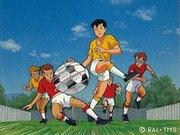Soccer Fever: What's the appeal of the anime about racing through the frenzy of the soccer pitch?

Soccer Fever: An animated masterpiece depicting the history and passion of soccer"Soccer Fever," which aired from 1994 to 1995, is an anime series that depicts the history of soccer and its passion. The series follows the history of the soccer World Cup from 1930 to 1994, and depicts the growth and friendship of the main characters Brian and Jim. It was produced as an original anime work, and was broadcast on NHK Satellite Broadcasting every Monday from 6:30 pm for 30 minutes, with a total of 52 episodes. Overview"Soccer Fever" was conceived and conceived by Marco Pagot and G Pagot, and co-produced by Tokyo Movie Shinsha, RAI and REVER. The series was written by Guerino Gentilini, Vitorios Chiraldi and Junichi Iioka, and the screenplay was written by Emanuele Giovannini, Francesco Maltalegno and Leopoldo Ciano. The character design was by Kazuyoshi Takeuchi, the animation directors were Satoshi Hirayama and Toyoaki Nakajima, the art director was Kazushige Takato, the cinematographer was Hajime Hasegawa and the sound director was Hiroshi Mukaiyama. The music was composed by Hitoshi Oda, adding to the overall atmosphere of the film. story"Soccer Fever" covers the history of soccer from the first World Cup in 1930 to the 1994 World Cup in the United States. The main characters, Brian and Jim, have been obsessed with soccer since childhood and overcome various difficulties as they grow up. Each episode depicts a historic match and the story of a player, delving deeply into the charm and history of soccer. For example, the first episode, "1930: A Journey to the World Cup," begins with Brian and Jim's first encounter with the soccer World Cup. The second episode, "1930: The First Uruguay Tournament," depicts the first World Cup held in Uruguay, and shows Brian and Jim being moved by the match. The third episode, "1930: The Glorious Lime Cup," depicts Uruguay's victory and the celebration that followed, and is an episode in which the friendship between Brian and Jim deepens. Thus, each episode depicts the story of a historic match or a player, and portrays the growth and friendship between Brian and Jim. Episode 4, "1934: The Ironclad Goalkeeper," depicts the exploits of the Italian goalkeeper, while episode 5, "1934: Italy," depicts the World Cup in Italy. Episode 6, "1934: The Fateful Rematch," depicts the tension of the rematch, and episode 7, "1934: The Light and Shadow of Italy," depicts Italy's victory and its aftermath. Episode 8, "1934: The Champion's Challenge," depicts Italy's challenge as the champion, and episode 9, "1936: The Black Antelope," depicts the success of black players. Episode 10, "1938: The France Tournament," depicts the World Cup in France, and episode 11, "1938: The Fierce Battle of Marseille," depicts the tension of the match in Marseille. Episode 12, "1938: Friendship Beyond Borders," is an episode in which Brian and Jim's friendship crosses borders. Episode 13, "1938: The Disgraced Champion," tells the story of a player who was disgraced as a champion, episode 14, "1939: The Last Peaceful Days," depicts the peaceful days before the war began, episode 15, "1940: A Warrior's Rest," depicts the players' rest during the war, and episode 16, "1942: Brian's Secret," reveals Brian's secret. Episode 17, "1950: The Challenge of Belo Horizonte," depicts the match at Belo Horizonte, while episode 18, "1950: The Man Called Dynamite," depicts the exploits of a player called Dynamite. Episode 19, "1950: The Riot at Maracana Stadium," depicts the riot at Maracana Stadium, and episode 20, "1953: The Void Cry at Wembley," depicts the tension of a match at Wembley. Episode 21, "1954: Stop! Hungary," depicts the strength of Hungary, while episode 22, "1954: An Astonishing Victory," tells the story of an astonishing victory. Episode 23, "1958: Stripped of Certification," tells the story of a player who was stripped of his qualifications, and episode 24, "1958: The Soccer Ball from Russia," tells the story of a soccer ball from Russia. Episode 25, "1958: For Victory!" tells the story of players fighting for victory, and episode 26, "1958: A Star is Born," is the episode in which a star is born. Episode 27, "1958: The Dawn of the Golden Age," depicts the beginning of the Golden Age, while episode 28, "1958: The Unlucky Champion," tells the story of the unlucky champion. Episode 29, "1962: The Final Moment," depicts the tension of the final moments, while episode 30, "1962: The Lucky Substitute," tells the story of the lucky substitute. Episode 31, "1962: The Magical Soccer Virus," tells the story of the magical soccer virus, and episode 32, "1962: The Brazilian Crisis," depicts the Brazilian crisis. Episode 33, "1966: The Sound of Violins," depicts a match set to the sound of violins, while episode 34, "1966: The Unexpected Team," tells the story of an unexpected team. Episode 35, "1966: The Player Discovered by the King," tells the story of a player discovered by the King, and episode 36, "1966: Goal Bangser," tells the story of Goal Bangser. Episode 37, "1966: The Mystery of Wembley," tells the mystery of Wembley, and episode 38, "1970: The Magic of Mexico," tells the magic of Mexico. Episode 39, "1970: The Legendary Match," tells the story of a legendary match, and episode 40, "1970: The Thwarted Kidnapping Plan," is the episode in which a kidnapping plan is thwarted. Episode 41, "1974: A Dreaming Letter," tells the story of a dreaming letter, and episode 42, "1974: East vs. West Germany," depicts the showdown between East and West Germany. Episode 43, "1974: The Kaiser's Victory," depicts the Kaiser's victory, and episode 44, "1978: Argentina," depicts the World Cup in Argentina. Episode 45, "1978: The Argentine Dream," depicts the Argentine dream, while episode 46, "1982: A Precious Autograph," tells the story of a precious autograph. Episode 47, "1982: The Night of Champions," tells the story of the night of champions, while episode 48, "1986: Battle of the Two Heroes," depicts the battle between the two heroes. Episode 49, "1986: The Boy with the Golden Legs," tells the story of the boy with the golden leg, and episode 50, "1990: The Tragedy of Naples," depicts the tragedy of Naples. Episode 51, "1990 Return Match," depicts the tension of the return match, and episode 52, "1994, The Night Before the 15th American Tournament," depicts the story of the night before the American Tournament. In this way, each episode depicts the stories of historic matches and players, and depicts the growth and friendship of Brian and Jim. characterThe main character, Brian, is obsessed with soccer from an early age and grows up while overcoming various difficulties. Brian is voiced by Masaaki Tsukada, and the young Brian is voiced by Masaki Aizawa. Jim is Brian's best friend, and together they pursue their soccer dreams. Jim is voiced by Takehiro Koyama, and the young Jim is voiced by Keiji Fujiwara. Ratings and Recommendations"Soccer Fever" is a highly acclaimed animated series that depicts the history and passion of soccer. Each episode depicts a historic match and the story of the players, and depicts the growth and friendship of Brian and Jim. The music and character design also add to the atmosphere of the series, drawing viewers in. This work is recommended not only for soccer fans, but also for those who are interested in sports and history. In particular, it is attractive that it depicts the growth and friendship of the main characters Brian and Jim while following the history of the soccer World Cup from 1930 to 1994. In addition, each episode depicts the story of a historic match and the players, delving deeply into the charm and history of soccer. In addition, "Soccer Fever" was broadcast on NHK Satellite TV every Monday from 6:30 pm for 30 minutes, with a total of 52 episodes. This work was produced as an original anime work, planned and conceived by Marco Pagot and G Pagot, and co-produced by Tokyo Movie Shinsha, RAI, and REVER. The series was composed by Guerino Gentilini, Vitorios Chiraldi, and Junichi Iioka, and the screenplay was written by Emanuele Giovannini, Francesco Maltalegno, and Leopoldo Ciano. The character design was by Kazuyoshi Takeuchi, the animation directors were Satoshi Hirayama and Toyoaki Nakajima, the art director was Kazushige Takato, the cinematographer was Hajime Hasegawa, and the sound director was Hiroshi Mukaiyama. In addition, Oda Jin was in charge of the music, which added to the overall atmosphere of the work. "Soccer Fever" is highly acclaimed as an animated series depicting the history and passion of soccer, and is recommended not only for soccer fans but also for those interested in sports and history. Each episode depicts the story of a historic match and the players, and the growth and friendship of Brian and Jim are depicted. The music and character design also add to the atmosphere of the work, and have the power to draw viewers in. This work is attractive in that it depicts the growth and friendship of the main characters Brian and Jim while following the history of the soccer World Cup from 1930 to 1994. In addition, each episode depicts the story of a historic match and the players, delving deeper into the charm and history of soccer. |
<<: I Love You! Nendo Mama - A Thorough Review of a Love-Filled Family Story
Recommend
"The moment the smile returns to the wind": Reevaluating the moving voice of Minna no Uta
"The Moment the Smile Returns to the Wind&qu...
Marvel's "Eternals" movie first releases Chinese subtitles trailer and poster
Marvel's "Eternals" movie released ...
Ryusei Sentai Otomet - A thorough analysis of the new appeal of the girl heroes and the depth of their battles
Ryuusei Sentai Otomet - Fascinating 3-episode fin...
The real car in the classic American TV series "Knight Rider" was sold for $200,000. The ancestor of smart cars
I believe that many old players have watched the ...
The second season of the TV animation "I'm Afraid of Pain, I Just Max Out My Defense" will be broadcast in 2022
The second season of the TV animation of the famo...
Nolan's new film "Tenet" may involve the intricacies of the quantum cold war time and space lines
The sci-fi film "Tenet," directed by Ch...
Chronicles of the Going Home Club: Evaluation and Recommendations for an Anime that Depicts the Charm of Everyday Life and the Reality of Youth
All-round evaluation and recommendation of "...
Director Gao Qunshu's new criminal investigation film "Trident" released its first trailer, with many veteran actors starring in it
The first trailer of the movie "Trident"...
The new Batman movie releases a new official Chinese subtitles TV trailer
"The New Batman" movie releases a new o...
The appeal and reviews of Night Wizard The ANIMATION: A magical world not to be missed
Night Wizard The ANIMATION - A tale of magic and ...
Japanese animation "Demon Slayer: Kimetsu no Yaiba the Movie" will be released in North America on April 23
On March 17, the Japanese animation "Demon S...
Female Spider-Man? Foreign media claims Sony is creating a "Spider-Man" series
There have been rumors for a long time that Sony ...
The new character of the animated film "Jujutsu Kaisen 0" Hanazawa Kana plays Rika Kimoto
The latest animated film "Jujutsu Kaisen 0&q...
"MOTHER: The Last Girl Eve" Review: A moving story and fascinating characters
MOTHER The Last Girl Eve - Movie Review and Detai...
Lucas's vision for Star Wars 8 is actually very similar to what we see
With the official conclusion of the nine Star War...









